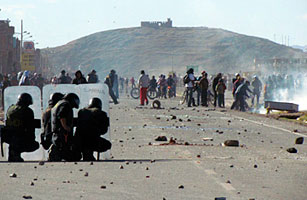
As a hearse bearing the body of Ral Cancapa made its way through the dark streets of Juliaca, a city in the Andes in southern Peru, on Saturday evening, June 25, the mourners tailing the procession solemnly chanted for justice. Cancapa’s widow walked with her relatives and gave a quick interview to local media before bursting into tears and being escorted into a car. “She’s in too much pain to talk,” said the brother of the dead man. The smell of burning tires filled the air as the convoy meandered through roadblocks in the besieged town. At a stop, a middle-aged man said Cancapa, 28, had not deserved to die, declaring, “The President should be punished for what has happened here.” As the procession passed by the airport, where Cancapa was killed, a couple of ladies swept up remnants of shattered glass.
Twenty-four hours before in the same spot, Cancapa, a farmer from San Anton, took part in one of the biggest protests to rock southern Peru in years. Joined by thousands who had come from throughout the region, Cancapa traveled two hours to Juliaca to demonstrate against the ongoing contamination of local waters, allegedly by Bear Creek, a Canadian mining company. The organizers of the campaign demanded that the government of President Alan Garca, who leaves office at the end of July, revoke its concession to the company. However, when the protesters approached the airport, fighting broke out, and the heavily armed police fired live rounds to disperse the crowds. Cancapa was hit in the chest and died immediately, one of six acknowledged by the government to have been killed over the weekend. Protesters assert that the number of dead is much higher.
The next day, the effects of the unrest were visible throughout the city. At the airport runway, a funeral was held for another victim of the violence, a 45-year-old man whose body, bruised and charred, was laid out on the road surrounded by candles in a makeshift memorial enclosed by removed airport fence. Next to him, his wife wept furiously as an enraged mob gathered to discuss what the protesters should do next. “What are you doing here? We don’t want press,” a woman said to me, angered by the sight of an Anglo — the current embodiment of the international corporations that the Aymara believe are to blame for the deaths and contamination. “President Garca has sold our country. We have nothing left, so we must fight to defend our land,” she said. The crowd around the dead body grew increasingly larger as people in turns released emotions and grievances.
Signs of anger toward the government and foreign companies were seen throughout the city. Anything that represents a foreign interest has been affected in some way. Bank windows have been smashed with rocks; a Chilean supermarket’s walls have been cracked; and the doors of a foreign-owned pharmacy chain downtown were broken in. “The people are not normally violent, but their livelihood is being destroyed by outsiders,” said one woman. Like many around the city, she was tying a black bag to a Peruvian flag to mourn the dead.
Special: “The World’s Most Polluted Places.”
Read
about Peru’s airport seige.